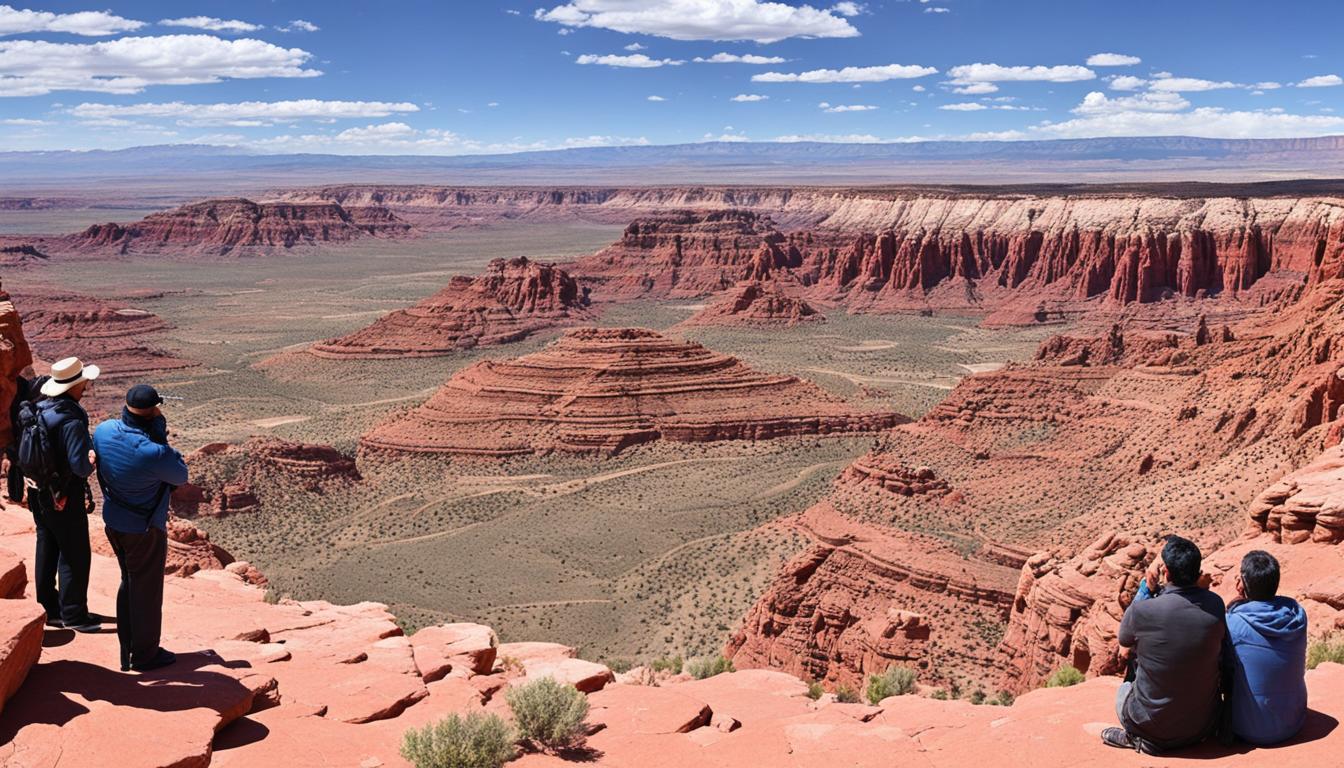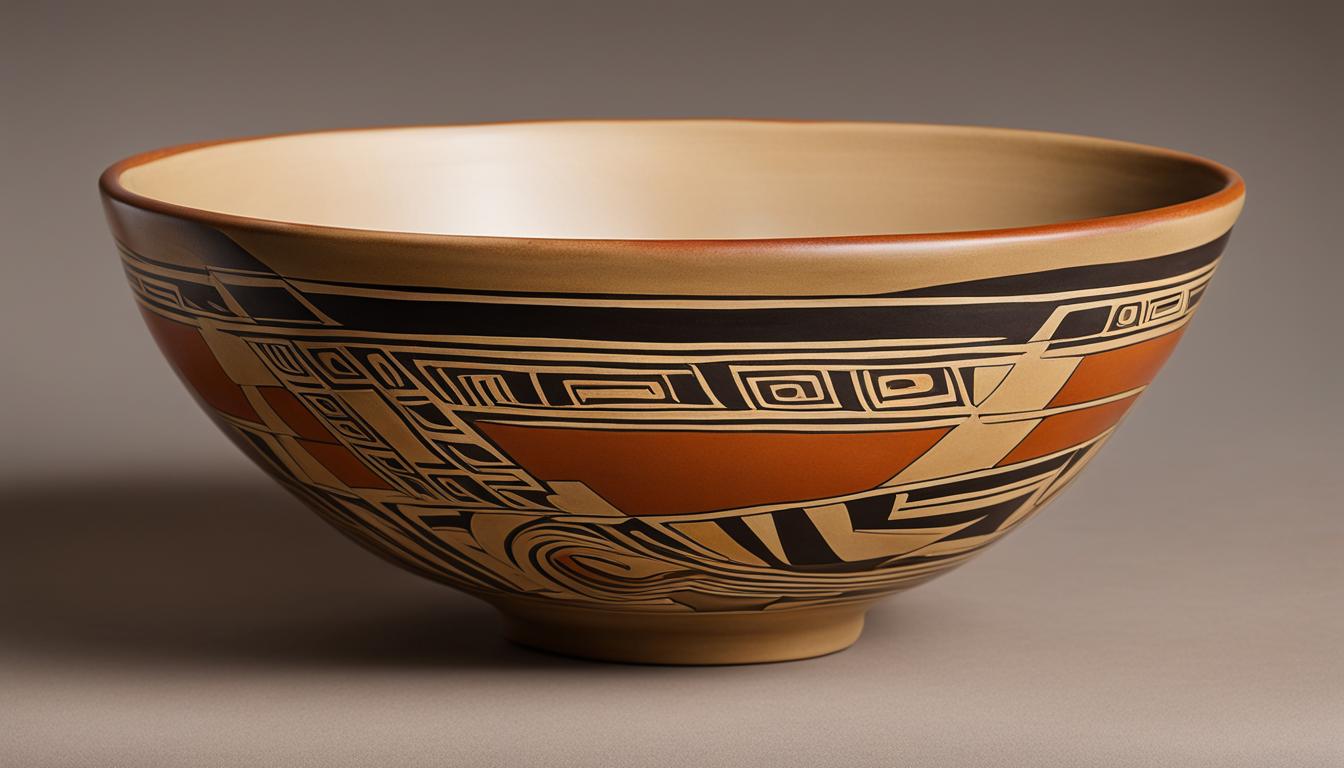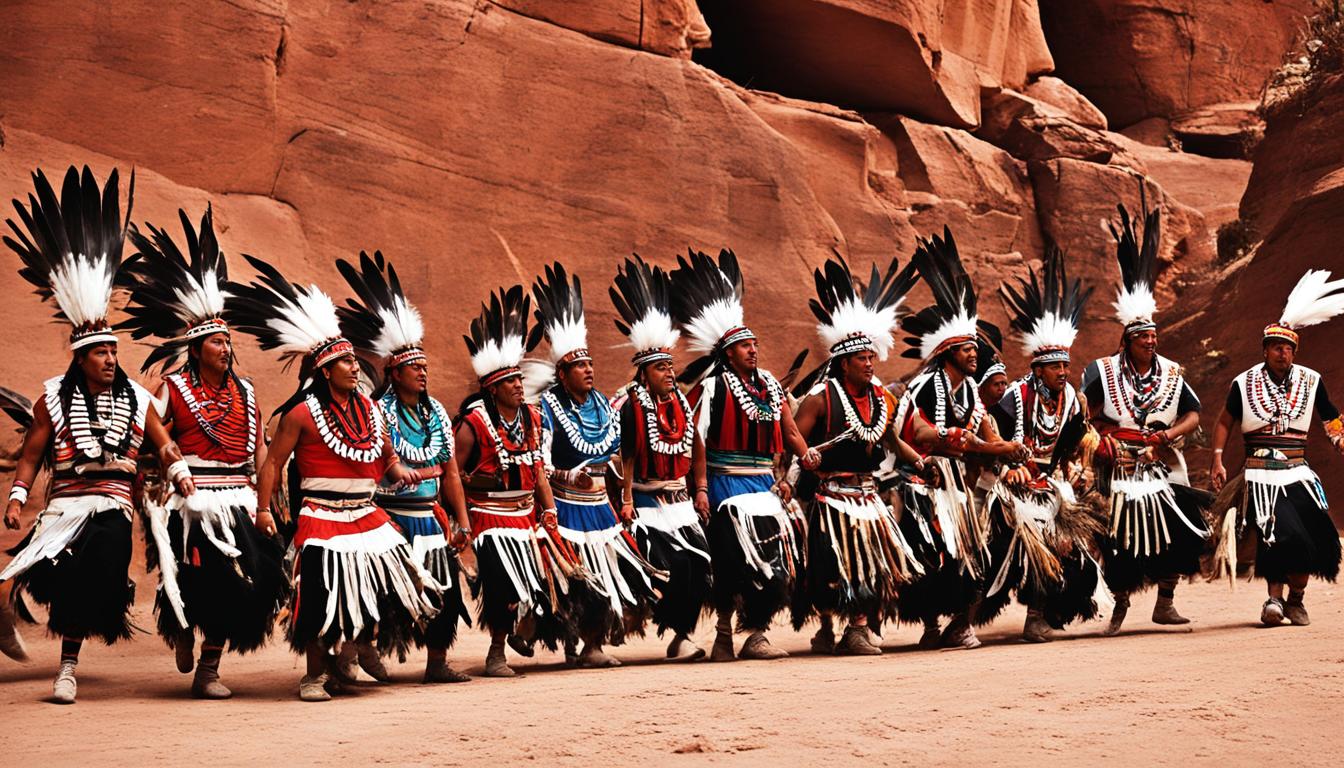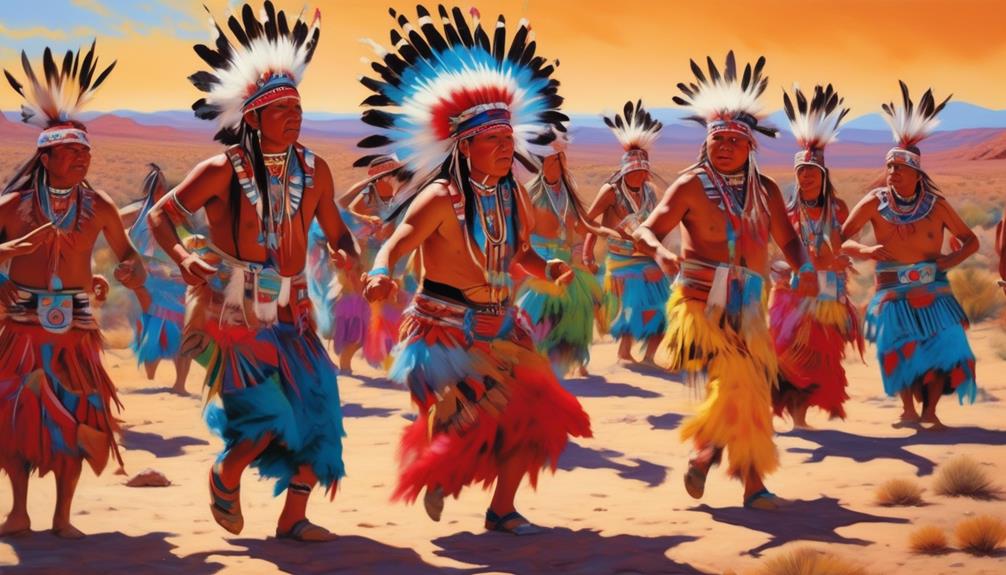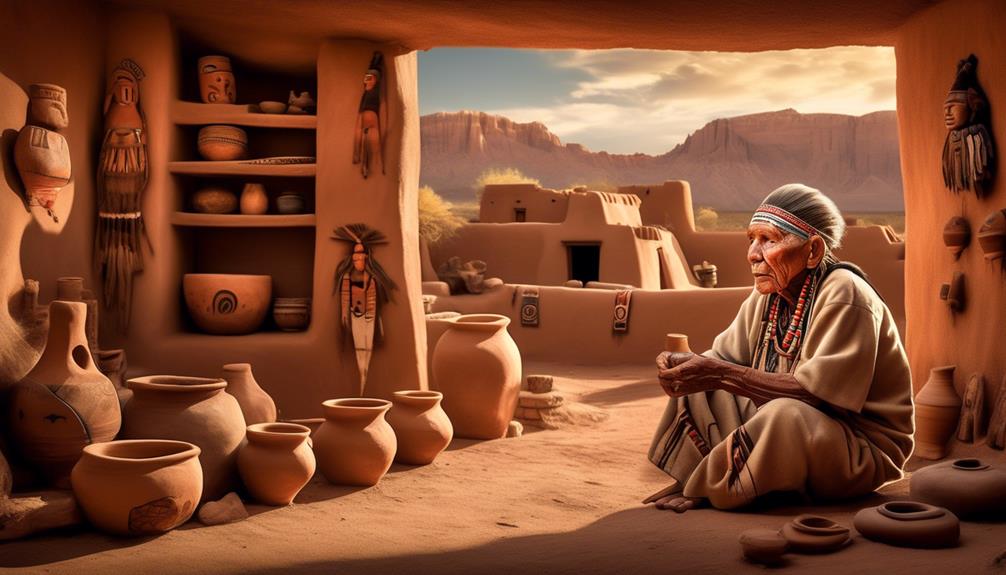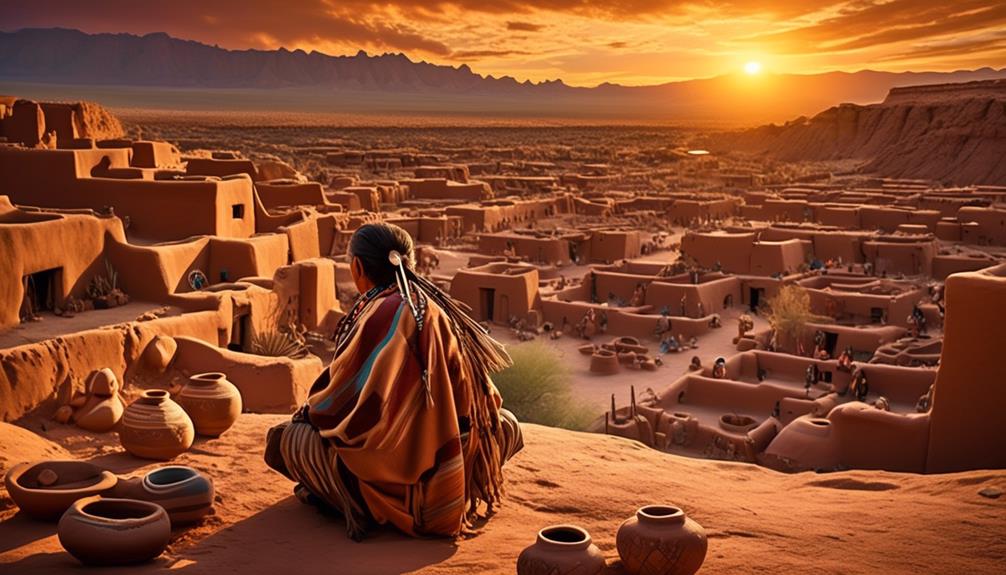Welcome to our guide to immersing yourself in the rich cultural history of the Hopi Tribe. Situated within the breathtaking landscapes of the Navajo Nation, the Hopi Tribe offers a unique and captivating experience for tourists looking to delve into the ancient traditions of one of the oldest Native American communities in the US. From the awe-inspiring mesas to the bustling villages, the Hopi Tribe invites you to discover their history, heritage, and sacred rituals.
Key Takeaways:
- Learn about the Hopi Tribe, one of the oldest indigenous communities in the United States.
- Explore the stunning mesas and villages nestled within the Navajo Nation.
- Immerse yourself in the unique culture, artistry, and traditions of the Hopi people.
- Experience guided tours, cultural activities, and authentic Hopi cuisine.
- Respect the customs and traditions of the Hopi people during your visit.
Hopi Tribe History and Culture
The Hopi people have a deep-rooted history that spans over 2,000 years in the land now known as Arizona. As ancient caretakers of the earth, they have upheld their rich culture, languages, and religion for centuries. The Hopi Tribe is internationally recognized for their exceptional artistry, with each village on the mesas specializing in different disciplines.
Embracing a humble farmer lifestyle, the Hopi people hold immense respect for the land they inhabit and maintain a profound connection to their ancestral traditions and spiritual beliefs.
From mesmerizing pottery and artistic paintings to traditional clothing, textiles, and intricate basketry, the Hopi culture radiates creativity and craftsmanship.
Hopi Tribe Mesas and Specializations
The Hopi Tribe’s villages are located on three towering mesas: First Mesa, Second Mesa, and Third Mesa. Each mesa has a distinct charm, showcasing the unique specialties of its respective village.
The Hopi villages on First Mesa are renowned for their exceptional handmade Hopi pottery, while the villages on Second and Third Mesas are known for their traditional Hopi clothing, textiles, wicker and coil plaques, and vibrantly colored yucca baskets. These exquisite creations exemplify the Hopi people’s deep cultural heritage and artistic skills.
Exploring the Hopi villages offers visitors a captivating journey into the heart of Hopi culture, where they can witness firsthand the immense talent and passion that exudes from each village’s unique craft.
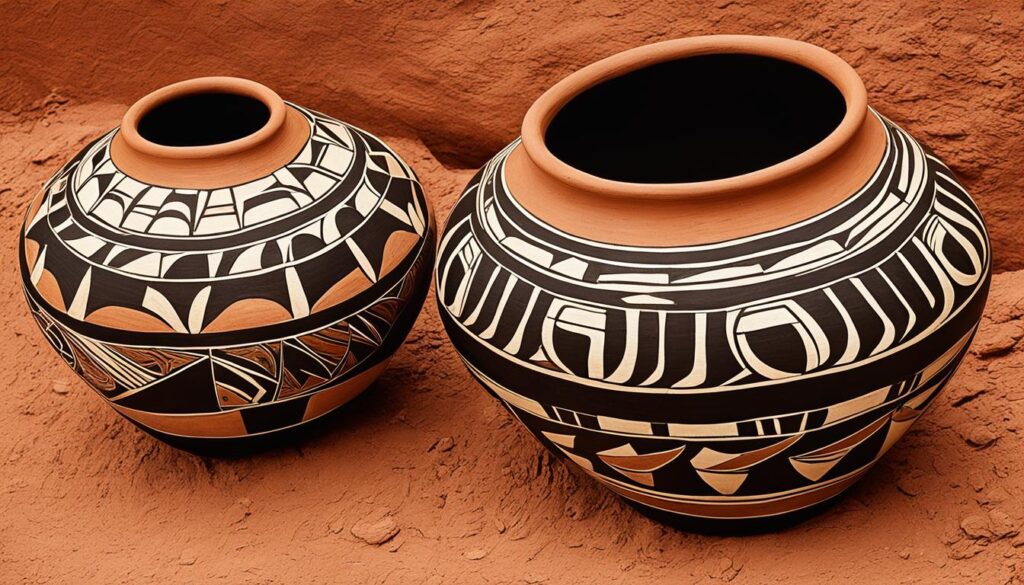
Hopi Tribe Traditions and Spiritual Beliefs
At the core of Hopi culture are the enduring traditions and spiritual practices that have shaped their way of life for countless generations. The Hopi people have a profound reverence for nature, viewing themselves as custodians of the earth.
“The Hopi Tribe’s profound connection to their ancestral roots is beautifully reflected in their spiritual beliefs and ceremonies,” says cultural anthropologist, Dr. Sophia Thompson. “Their ceremonial dances, such as the renowned Snake Dance, provide a glimpse into the rich tapestry of Hopi spirituality.”
The Hopi’s traditions and spiritual beliefs are deeply intertwined with their agricultural practices, emphasizing the importance of harmony with nature and the cycles of life.
Hopi Tribe Language and Oral Traditions
The Hopi people have preserved their unique languages, ensuring the continuity of their cultural heritage. Hopi, the primary language spoken, is a rich and complex linguistic system unique to the tribe. Hopi children are taught the language from a young age, preserving this vital aspect of their identity.
Beyond language, the Hopi people also uphold a vibrant tradition of oral storytelling. Through stories and legends passed down through generations, they transmit their knowledge, values, and history to younger members of the tribe, fostering a greater understanding and appreciation for their cultural legacy.
Hopi Tribe and Spiritual Teachings
| Teachings | Meaning |
|---|---|
| Katsinam | Representative spirits of nature and ancestors, guiding the Hopi people in their spiritual journey. |
| Hopi Prophecies | Sacred predictions shared through oral transmission, reflecting the Hopi people’s spiritual connection with the past, present, and future. |
| Balance and Harmony | Emphasize the importance of living in harmony with nature, maintaining social cohesion, and fostering peace within oneself and the community. |
| Moral Values | Include concepts like humility, cooperation, respect, and compassion, which guide the Hopi people in their daily lives. |
The Hopi Tribe’s spiritual teachings encompass a profound respect for nature and the interconnectedness of all living beings. These teachings provide a guiding compass for the Hopi people, ensuring the preservation of their cultural identity and facilitating their harmonious existence with the world around them.
Exploring the Hopi Mesas
The Hopi Tribe consists of twelve villages nestled on three majestic mesas: First Mesa, Second Mesa, and Third Mesa. Each mesa offers its own unique charm and specialties, allowing visitors to immerse themselves in the rich culture of the Hopi people.
When exploring the Hopi reservations, a visit to Walpi on the First Mesa is a must. This village is the only one that offers organized tours to visitors, providing an opportunity to gain insights into the daily lives and traditions of the Hopi people. Additionally, independent tour guides can be hired to explore the other villages, ensuring a comprehensive and personalized experience.
Let’s take a closer look at what each mesa has to offer:
First Mesa
- Experience the artistry of handmade Hopi pottery, known for its intricate designs and vibrant colors
- Discover the history and symbolism behind each unique pottery piece
- Witness the pottery-making process and learn about the traditions passed down through generations
Second Mesa
- Explore traditional Hopi clothing and textiles, showcasing the exquisite craftsmanship of the Hopi people
- Learn about the cultural significance of clothing and textiles in Hopi ceremonies and everyday life
- Discover the techniques used to create stunning garments and intricate weavings
Third Mesa
- Experience the vibrant colors and intricate patterns of wicker and coil plaques, traditional Hopi crafts
- Learn about the materials and techniques used to create these unique pieces
- Appreciate the cultural significance and symbolism behind each creation
Exploring the Hopi mesas is a journey of discovery, allowing visitors to appreciate the rich heritage and artistic traditions of the Hopi people. From intricate pottery to vibrant textiles, each mesa offers a unique and immersive experience into the heart of Hopi culture.
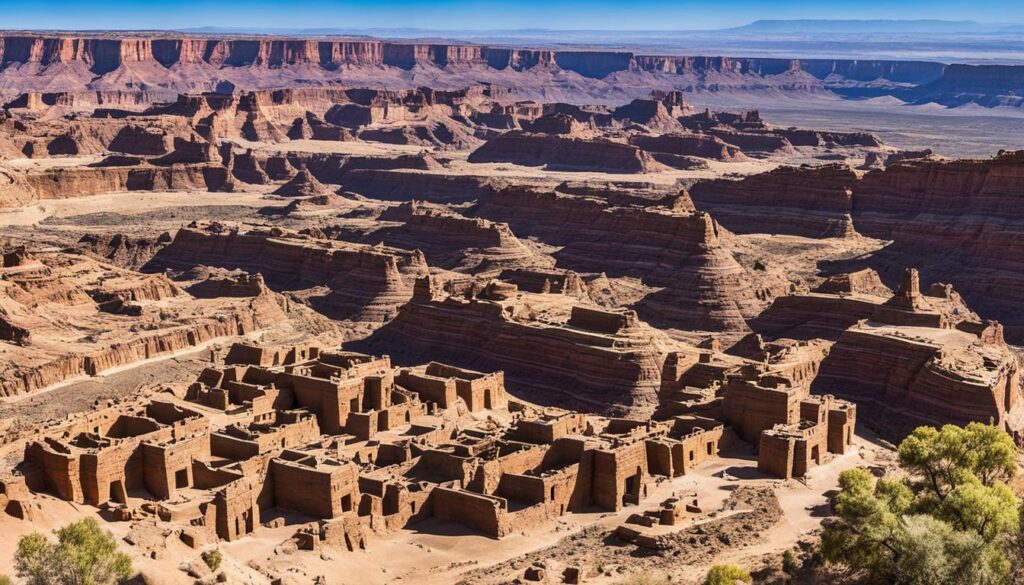
Hopi Arts and Crafts
The Hopi people are internationally renowned for their artistry, showcasing their rich cultural heritage through their exquisite arts and crafts. Each mesa within the Hopi Tribe specializes in different artistic disciplines, offering visitors a diverse and captivating experience.
First Mesa – Handmade Hopi Pottery, Paintings, and Carvings
First Mesa is known for its exceptional handmade Hopi pottery, characterized by intricate designs and vibrant colors. Hopi potters use traditional techniques passed down through generations to create unique pieces that reflect their spiritual beliefs and connection to the land. These beautiful pottery pieces, ranging from delicate bowls to striking jars, serve both functional and ceremonial purposes.
In addition to pottery, First Mesa is also home to talented Hopi painters and carvers. Their artistic creations capture the essence of Hopi traditions, depicting ceremonial dances, kachina spirits, and stories of ancestral wisdom. These remarkable artworks offer a glimpse into the cultural significance and deep spirituality of the Hopi people.
Second and Third Mesas – Traditional Hopi Clothing, Textiles, Plaques, and Baskets
Second and Third Mesas are renowned for their traditional Hopi clothing and textiles, showcasing the craftsmanship and intricate designs of Hopi weavers. These vibrant textiles, often made from cotton and wool, feature symbolic patterns and motifs representing various aspects of Hopi culture. Visitors can witness the weaving process and even purchase these beautifully crafted textiles as souvenirs or art pieces.
Wicker and coil plaques are another unique art form found on Second and Third Mesas. Hopi artisans create these intricate plaques using natural materials such as yucca fibers, corn husks, and willow shoots. These plaques, often adorned with intricate patterns and symbolism, are treasured as decorative pieces and can be found in Hopi homes and galleries throughout the mesas.
Lastly, visitors can marvel at the skill of Hopi basket weavers. These talented artisans create stunning multicolored yucca baskets, incorporating natural dyes and intricate designs into their work. Hopi baskets are admired for their durability and beauty, often passed down as cherished heirlooms.
To fully appreciate the artistry of the Hopi people, visitors can explore the Hopi Arts Trail, which connects various galleries and studios in the villages throughout Hopi tribal lands. This trail offers a unique opportunity to interact with Hopi artisans, learn about their creative processes, and acquire authentic Hopi arts and crafts.
| Mesa | Artistic Disciplines |
|---|---|
| First Mesa | Handmade Hopi Pottery, Paintings, Carvings |
| Second and Third Mesas | Traditional Hopi Clothing, Textiles, Wicker and Coil Plaques, Multicolored Yucca Baskets |
Cultural Experiences at Hopi
A visit to the Hopi Tribe offers a unique cultural experience. Join us on guided tours of the villages, where you can immerse yourself in the traditional way of life, spiritual traditions, and daily activities of the Hopi people. Our knowledgeable guides will share fascinating insights into the rich history and vibrant culture of the tribe.
Experience the awe-inspiring ceremonial dances that are revered among the Hopi, including the famous Snake Dance. While many of these dances are closed to the public, social dances held in village plazas and streets offer an opportunity to witness the cherished traditions of the Hopi people firsthand. Feel the rhythm of the drums, witness the intricate movements, and be captivated by the vibrant costumes.
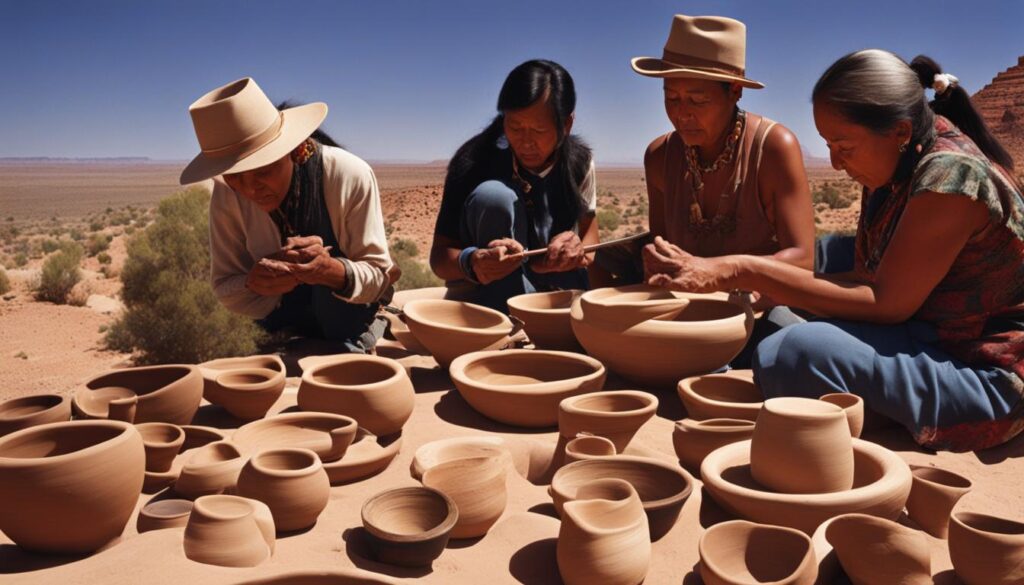
“Being part of the Hopi ceremonial dances was a truly transformative experience. The deep spirituality and connection to nature were palpable.” – Sarah, Visitor
Upcoming Hopi Tribal Dances:
- Katsina Dances – Celebrating the spirits of ancestral beings, these dances occur throughout the year.
- Snake Dance – A biennial event held in August, this powerful ceremony involves the handling of live snakes.
- Soohlo Dance – Celebrated on the Hopi’s New Year’s Day, this dance signifies a fresh beginning and renewing of harmony.
Embark on a cultural journey like no other and discover the rich traditions and spiritual heritage of the Hopi Tribe. Our tours provide a glimpse into a cherished culture that has stood the test of time.
| Dance | Schedule | Location |
|---|---|---|
| Katsina Dances | Ongoing throughout the year | Village plazas and streets |
| Snake Dance | Biennial event in August | Walpi village |
| Soohlo Dance | New Year’s Day | Various villages |
Hopi Tribal Accommodations and Tour Options
When visiting the Hopi Tribe, accommodations and tour options are essential considerations to ensure a memorable and immersive experience. Two notable options for travelers are the Hopi Cultural Center on Second Mesa and the Moenkopi Legacy Inn & Suites near Tuba City, which both offer unique opportunities to explore the rich history and culture of the Hopi people.
Hopi Cultural Center

The Hopi Cultural Center, located on Second Mesa, serves as a hub for visitors seeking a deeper understanding of the Hopi Tribe. Along with an inn and restaurant, the center features a captivating gallery that showcases the artistic and cultural heritage of the Hopi people. Guests can explore traditional Hopi arts and crafts, including pottery, paintings, and textiles, which provide insights into the tribe’s ancestral traditions.
Immerse yourself in the rich history of the Hopi Tribe and discover the beauty of their artistry at the Hopi Cultural Center. From the intricate pottery to the vibrant paintings, every piece tells a story that spans centuries.
Moenkopi Legacy Inn & Suites
For those looking to combine their Hopi Tribe experience with visits to famous Arizona landmarks, the Moenkopi Legacy Inn & Suites near Tuba City provides an excellent base. This hotel offers comfortable accommodations and approved guides who can arrange tours of the Hopi reservations. Located within close proximity to attractions such as Antelope Canyon and Canyon de Chelly, it offers convenience and accessibility to explore the Southwest’s natural wonders.
Experience the best of both worlds – the serenity of the Hopi Tribe and the majestic beauty of Arizona’s iconic landmarks. Stay at the Moenkopi Legacy Inn & Suites for a well-rounded and unforgettable journey.
Whether you choose to stay at the Hopi Cultural Center or the Moenkopi Legacy Inn & Suites, both options ensure a comfortable stay and provide valuable insight into the Hopi Tribe’s cultural heritage.
Hopi Tribe Tourism Logistics
Visiting the Hopi Tribe requires some logistical considerations. The land of the Hopi is located within the Navajo Nation, and guided tours are the only way to access the villages. Walpi on First Mesa is the only village that offers organized tours to visitors. Independent tour guides, certified by the tribe, can be hired to visit the other villages. It is also important to respect the cultural customs and traditions of the Hopi people during your visit.
When planning your trip to the Hopi Tribe, it is essential to understand the logistics involved. Being located within the Navajo Nation, access to the Hopi lands is restricted and requires guided tours. Walpi, situated on First Mesa, offers organized tours to visitors, providing an opportunity to explore the village and learn about the Hopi culture. However, if you wish to visit the other villages, it is advisable to hire an independent tour guide certified by the tribe. These guides possess a deep understanding of the area, its history, and the traditions of the Hopi people, ensuring a meaningful and respectful experience.
Respect for the Hopi culture is paramount during your visit. The Hopi people hold their customs and traditions sacred, and it is essential to honor and follow their guidelines. Be mindful of their cultural practices, such as photography restrictions in certain areas and the respectful treatment of sacred sites. By being sensitive to their customs, you can contribute to a positive and mutually beneficial cultural exchange.
| Logistical Considerations for Visiting the Hopi Tribe: | |
|---|---|
| Location: | Located within the Navajo Nation in Arizona. |
| Access: | Guided tours are the only way to access the Hopi villages. |
| Organized Tours: | Walpi on First Mesa offers organized tours for visitors. |
| Independent Guides: | Certified independent tour guides can be hired to visit other villages. |
| Cultural Respect: | Respect the customs and traditions of the Hopi people during your visit. |
Exploring Hopi Reservations and Villages
As you journey along Arizona State Route 264, you’ll discover the scattered Hopi villages, each with its own unique history and architectural wonders. These villages showcase the rich cultural heritage of the Hopi Tribe. One such village that offers a breathtaking view is Walpi, perched atop First Mesa at an elevation of 6,000 feet. From this vantage point, visitors can marvel at the panoramic landscapes while immersing themselves in the daily life of the Hopi people.
Let us take you on a tour of the other Hopi villages, each brimming with its own distinct characteristics and cultural significance:
- Sichomovi: Discover the traditional Hopi architecture and experience the warmth of the community spirit.
- Hano: Explore the centuries-old structures and enjoy the scenic beauty of this village.
- Polacca: Get a glimpse of the vibrant Hopi culture and engage with talented artisans.
- Shungopavi: Immerse yourself in the ceremonial traditions of the Hopi people.
- Mishongnovi: Marvel at the stunning views and embrace the tranquility of this picturesque village.
- Sipaulovi: Experience the harmonious blend of traditional and contemporary Hopi life.
- Oraibi: Visit one of the oldest continuously inhabited villages in the United States and witness the timeless traditions of the Hopi people.
- Hotevilla: Engage with community members and learn about the daily practices that sustain Hopi culture.
- Bacavi: Delve into the history and spirituality of this village, which holds a special place in Hopi folklore.
These villages offer a glimpse into the rich tapestry of Hopi life, with their unique architecture reflecting the tribe’s enduring connection to their ancestral lands.
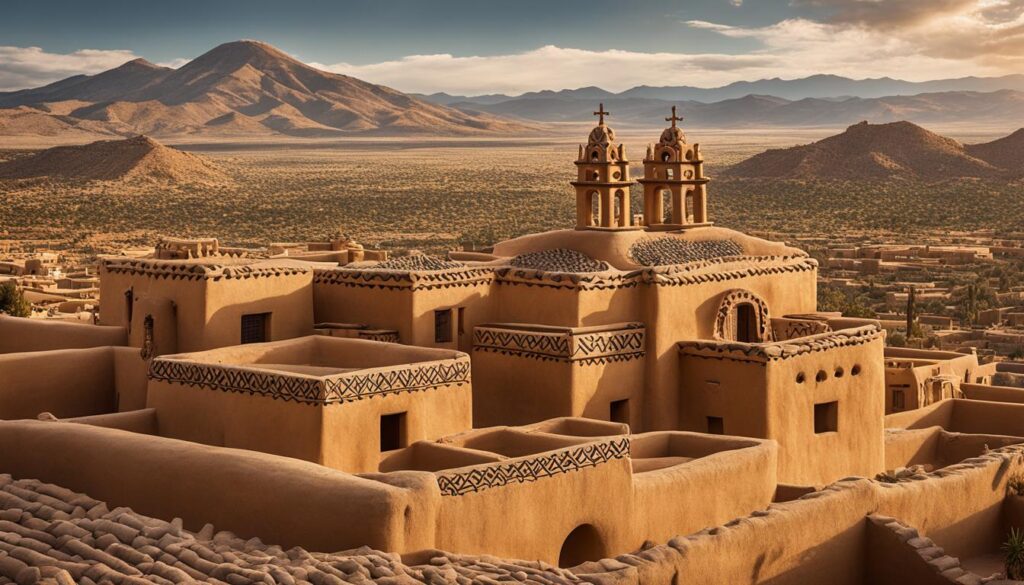
Authentic Hopi Dining
Visitors to the Hopi Tribe can savor the flavors of authentic Hopi cuisine at the Hopi Cultural Center. Our center offers a delightful culinary experience that allows you to immerse yourself in the rich traditions of the Hopi people. Indulge in traditional Hopi dishes and sample the local flavors for a truly memorable dining experience.
“The flavors of traditional Hopi cuisine are a true reflection of our vibrant culture and heritage.”
At the Hopi Cultural Center, you can enjoy a variety of traditional Hopi food, carefully prepared with fresh ingredients and traditional techniques. From hearty stews made with corn and beans to flavorful roasted meats and tender breads, every dish tells a story and connects you to the Hopi way of life.
For those who prefer more familiar options, our center also offers a selection of American-style dishes. Whether you choose to dive into the exotic flavors of Hopi cuisine or opt for something familiar, our culinary offerings cater to all tastes and preferences.
Sample Hopi Cuisine
Here are some must-try dishes from our authentic Hopi menu:
- Piki Bread: Delicate cornbread made from blue cornmeal, cooked on heated stone slabs.
- Hominy Soup: A comforting soup made with corn kernels soaked in alkaline water and cooked until tender.
- Bean and Corn Stew: A hearty combination of beans, corn, and traditional Hopi spices.
- Frybread: Fluffy, golden-brown bread made from dough that is fried until crispy on the outside and soft on the inside. Perfect for dipping and savoring.
These dishes, prepared with love and care, take you on a gastronomic journey through Hopi traditions and flavors. Pair your meal with a refreshing beverage, such as a traditional corn drink or a freshly brewed Hopi tea, for a complete dining experience.
By indulging in authentic Hopi cuisine, you not only tantalize your taste buds but also gain a deeper understanding of our unique culture and heritage. So, don’t miss the opportunity to savor the delicious tastes of Hopi cuisine during your visit to the Hopi Tribe.
Hopi Tribe Tourism with Local Guides
To get the most out of your visit to the Hopi Tribe, consider hiring a local guide. Certified Hopi guides can provide in-depth knowledge about the history, culture, and traditions of the Hopi people. They can also offer a more intimate and personal experience, allowing you to connect with the local community on a deeper level. Hiring a guide ensures a meaningful and educational journey through the Hopi lands.
Hopi Tribal Ceremonies and Dances
The Hopi Tribe celebrates a rich tapestry of religious ceremonies and dances that are deeply rooted in their spiritual traditions. These sacred rituals are an integral part of Hopi culture, reflecting their connection to the natural world and their reverence for the divine.
One of the most significant ceremonies is the masked kachina dances, which take place from January to July. These dances symbolize the spirits of various elements, such as rain, fertility, and healing. The kachina dancers wear elaborate masks and costumes, transforming into the spiritual beings they represent. However, it’s important to note that most kachina dances are closed to the public, as they are reserved for the Hopi community.
For visitors who wish to witness Hopi ceremonies and dances, social dances offer an opportunity to experience the vibrancy of Hopi culture. These public dances are typically held from August to February and showcase the unique music, dance, and storytelling traditions of the Hopi people. It’s a chance to immerse yourself in the sights and sounds that have mesmerized generations.
One of the most renowned Hopi ceremonies is the biennial Snake Dance. Dating back centuries, this powerful ritual involves the handling of live snakes by dancers as a means of purification and fertility. The Snake Dance is performed with utmost reverence and devotion, reinforcing the Hopi’s deep spiritual connection to the natural world.
Through their ceremonies and dances, the Hopi Tribe invites us to witness their enduring spiritual traditions and glimpse the profound beauty of their ancient culture.
| Ceremony/Dance | Time of Year | Significance |
|---|---|---|
| Masked Kachina Dances | January to July | Represent spirits of various elements |
| Social Dances | August to February | Opportunity to experience Hopi culture |
| Snake Dance | Performed biennially | Purification and fertility ritual |
Hopi Tribe Tour Packages
Are you ready to embark on a memorable journey through the enchanting lands of the Hopi Tribe? Our tour packages offer the perfect opportunity to explore the rich culture, traditions, and natural beauty of the Hopi Tribe.
With our guided tours, you can witness the mesmerizing dances and ceremonies that have been passed down through generations. Immerse yourself in the vibrant atmosphere as you learn about the Hopi’s deep spiritual connection with the land.
Our knowledgeable guides will take you on a captivating exploration of the Hopi villages, where you can witness firsthand the ancient architecture, breathtaking landscapes, and exquisite artistry of the Hopi people.
Experience the warmth and hospitality of the Hopi Tribe as you stay in comfortable accommodations, enjoy delicious traditional meals, and create lasting memories with fellow travelers.
“The tour package allowed us to delve into the heart of the Hopi Tribe, connecting with their vibrant culture and witnessing their ancestral traditions. It was a truly transformative experience.”
Choose from a variety of tour packages that suit your preferences and schedule. Whether you’re interested in a short immersive experience or a comprehensive exploration, we have the perfect package for you.
| Tour Package | Duration | Highlights |
|---|---|---|
| The Hopi Explorer | 3 days | Guided tours of Hopi villages, cultural experiences, traditional ceremonies and dances |
| Spirit of the Hopi | 7 days | Extended exploration of Hopi villages, exclusive access to sacred sites, in-depth cultural immersion |
| Hopi and Native American Heritage | 10 days | Combines Hopi Tribe tour with visits to other Native American tribes and iconic Southwest landmarks |
Book your Hopi Tribe tour package today and embark on a soul-stirring adventure into the heart of one of the oldest Native American tribes in the United States.
Hopi Tribe and Navajo Nation
The Hopi Tribe is located within the Navajo Nation, which is the largest Native American reservation in the United States. When planning a visit to the Hopi Tribe, it is important to understand the relationship between the Hopi and Navajo people. The Navajo Nation encompasses a vast land area and is home to multiple Native American tribes, each with their own distinct cultures and traditions. Exploring both the Hopi Tribe and the Navajo Nation allows visitors to gain a deeper appreciation of Native American heritage.
Although the Hopi Tribe is located within the Navajo Nation, it has its own unique customs, language, and traditions. The Hopi people have lived on their land for over 2,000 years and have a rich cultural history that is worth exploring. By visiting both the Hopi Tribe and the Navajo Nation, travelers can witness the diversity and beauty of Native American cultures in the Southwest.
While planning your trip, consider incorporating visits to other areas within the Navajo Nation, such as Monument Valley, Canyon de Chelly, or Antelope Canyon. These iconic natural landmarks provide stunning backdrops to the cultural experiences offered by the Hopi Tribe and the Navajo Nation.
“Exploring the Hopi Tribe within the larger context of the Navajo Nation allows us to fully appreciate the rich tapestry of Native American cultures. It’s an opportunity to learn and respect the customs and histories of both tribes, and gain a deeper understanding of the Southwest’s indigenous peoples.”
– Hopi and Navajo Connection Tours
Hopi Tribe and Southwest Landscapes
The Hopi Tribe is surrounded by the stunning landscapes of the Southwest. When you visit the Hopi lands, you have the opportunity to explore famous Arizona landmarks, including Antelope Canyon and Canyon de Chelly. These natural wonders showcase the unique geology and breathtaking beauty of the region.
Antelope Canyon, located near Page, Arizona, is a slot canyon known for its mesmerizing light beams and vibrant sandstone walls. As you walk through the narrow passageways, you’ll witness the interplay of light and shadows, creating a visual spectacle that captivates visitors.
Canyon de Chelly, located within the Navajo Nation, offers a rich historical and cultural experience. This deep sandstone canyon is home to ancient ruins, rock art, and spectacular vistas. Guided tours are available to explore the various ruins and learn about the canyon’s significance to the Hopi and other Native American tribes in the area.
The Hopi Cultural Center, located on Second Mesa, is a convenient base for travelers as it is in close proximity to these iconic landmarks. After a day of immersing yourself in the vibrant Hopi culture, you can venture out to witness the awe-inspiring beauty of Antelope Canyon and Canyon de Chelly.
Exploring the Southwest landscapes in conjunction with the Hopi Tribe visit enhances the overall cultural and spiritual experience. It provides a deeper understanding of the profound connection between the Native American people and their stunning natural surroundings.
Planning a Hopi Tribe Trip
When planning a trip to the Hopi Tribe, there are several logistical considerations to keep in mind. From transportation and accommodations to guided tours, careful planning ensures a smooth and enjoyable journey through the rich heritage of the Hopi people. To make the most of your visit, we recommend following these essential steps:
1. Research Tour Operators
Start by researching tour operators that specialize in Hopi Tribe tourism. Look for operators with a reputable track record and positive customer reviews. Consider their offerings, such as guided tours, transportation, and accommodations. Finding the right tour operator will ensure a well-organized and informative experience. Here are a few reliable tour operators:
- Hopi Cultural Center Tours
- Hopi Tours
- Explore Hopi
2. Connect with Certified Hopi Guides
To gain a deeper understanding of the Hopi culture, consider connecting with certified Hopi guides. These knowledgeable experts can provide valuable insights into the history, traditions, and spiritual practices of the Hopi people. They can also offer a more personalized experience, allowing you to engage with the local community on a deeper level. Here are some certified Hopi guides who can enhance your trip:
- Mark A. Tahbo – Hopi Cultural Guide
- Paula Starr – Hopi Tribe Heritage Guide
- David Dawangyumptewa – Hopi Cultural Ambassador
3. Book Transportation and Accommodations
Arrange transportation to and within the Hopi Tribe. Consider renting a car for easy exploration of the mesas and villages. Additionally, book your accommodations in advance to ensure a comfortable stay. The following options provide convenient access to the Hopi Tribe:
- Hopi Cultural Center Inn
- Moenkopi Legacy Inn & Suites
4. Respect Cultural Customs and Traditions
When visiting the Hopi Tribe, it is essential to respect the cultural customs and traditions of the Hopi people. Listen to your guides’ instructions and follow their recommendations. Keep in mind that certain ceremonies and dances are considered sacred and may not be open to the public. Be mindful of your behavior, dress modestly, and avoid interrupting or intruding on any spiritual practices.
“Respect for the Hopi Tribe’s customs and traditions is crucial. We must approach their land with reverence and humility, honoring their rich cultural heritage.”
Planning your Hopi Tribe trip with these considerations in mind will ensure a meaningful and respectful experience. By engaging with certified guides, supporting local tour operators, and immersing yourself in the customs and traditions of the Hopi people, you will create lasting memories and forge a deeper connection with this vibrant Native American tribe.
| Tour Operator | Services Offered | Contact Information |
|---|---|---|
| Hopi Cultural Center Tours | Guided tours, accommodations | (123) 456-7890 info@hopiculturalcentertours.com |
| Hopi Tours | Customized tours, transportation | (123) 456-7890 info@hopitours.com |
| Explore Hopi | Cultural experiences, workshops | (123) 456-7890 info@explorehopi.com |
Conclusion
A visit to the Hopi Tribe is an extraordinary opportunity to immerse yourself in the vibrant culture and timeless traditions of this ancient Native American tribe. Exploring the ancient mesas and villages, you’ll witness the rich history and deep connection that the Hopi people have with their land.
By hiring a local guide, you’ll gain deep insights into the Hopi’s way of life, their customs, and their spiritual beliefs. These expert guides will enhance your understanding and appreciation of the Hopi Tribe, ensuring a meaningful and educational experience.
Plan your trip to the Hopi Tribe and embark on a serene journey into an ancient and enduring culture. From awe-inspiring landscapes to traditional ceremonies and dances, hopi tribe tourism offers a unique and enriching cultural experience that will leave a lasting impression.
FAQ
Can I visit the Hopi Tribe on my own?
No, visiting the Hopi Tribe requires guided tours. Walpi on First Mesa is the only village that offers organized tours to visitors, but independent tour guides can be hired to visit other villages.
What can I expect to see at the Hopi Cultural Center?
The Hopi Cultural Center, located on Second Mesa, offers a gallery, restaurant, and inn where visitors can immerse themselves in the rich history of the area.
What are the specialties of each Hopi mesa village?
First Mesa is known for handmade Hopi pottery, artistic paintings, and Hopi carvings. Second and Third Mesas are known for traditional Hopi clothing and textiles, wicker and coil plaques, and multicolored yucca baskets.
What activities can I participate in during a visit to the Hopi Tribe?
Visitors can participate in guided tours of the villages, where they can learn about the Hopi people’s traditional way of life, spiritual traditions, and daily activities. They can also witness social dances that offer a glimpse into the cherished culture of the Hopi people.
Where can I stay near the Hopi Tribe?
The Hopi Cultural Center offers an inn and restaurant for visitors. Travelers can also consider staying at Moenkopi Legacy Inn & Suites near Tuba City, which offers approved guides and tours while being conveniently located near famous Arizona landmarks.
How can I visit the other Hopi villages?
To visit the other Hopi villages, you can hire independent tour guides who are certified by the tribe. They can provide transportation and knowledgeable insights into the history, culture, and traditions of the Hopi people.
What are the best Hopi villages to visit for learning about Hopi culture?
Walpi on First Mesa offers a picturesque view and is the best place for visitors to learn about life in the Hopi villages. Each village, such as Sichomovi, Hano, Polacca, Shungopavi, Mishongnovi, Sipaulovi, Oraibi, Hotevilla, and Bacavi, has its own distinct characteristics and cultural significance.
What kind of food can I try at the Hopi Cultural Center?
The Hopi Cultural Center offers traditional Hopi food, as well as more familiar American-style options. It is recommended to try traditional Hopi dishes to fully experience the local flavors.
Should I hire a local guide during my visit to the Hopi Tribe?
Hiring a local guide is highly recommended. Certified Hopi guides can provide in-depth knowledge about the history, culture, and traditions of the Hopi people, ensuring a more intimate and personal experience.
Are all Hopi tribal ceremonies and dances open to the public?
Most ceremonial dances, including masked kachina dances, are closed to the public. However, social dances that are usually held from August to February offer a glimpse into the rich cultural traditions of the Hopi people. The Snake Dance, one of the most famous ceremonies, is performed biennially and involves the handling of snakes.
Are there tour packages available for visiting the Hopi Tribe?
Yes, various tour packages are available. These packages offer guided tours of the villages, cultural experiences, and the opportunity to witness traditional ceremonies and dances. Tour operators provide transportation, knowledgeable guides, and often include meals and accommodations.
How does the Hopi Tribe relate to the Navajo Nation?
The Hopi Tribe is located within the Navajo Nation, the largest Native American reservation in the United States. Understanding the relationship between the Hopi and Navajo people is important when visiting the Hopi Tribe, as the Navajo Nation encompasses multiple Native American tribes, each with their own distinct cultures and traditions.
What other landmarks can I explore near the Hopi Tribe?
Visitors to the Hopi Tribe can also explore famous Arizona landmarks such as Antelope Canyon and Canyon de Chelly. The proximity of the Hopi Cultural Center to these landmarks makes it a convenient base for travelers to experience both cultural and natural beauty.
What should I consider when planning a trip to the Hopi Tribe?
When planning a trip to the Hopi Tribe, it is important to consider logistics such as transportation, accommodations, guided tours, and respect for the cultural customs and traditions of the Hopi people. Researching tour operators and connecting with certified Hopi guides will ensure a well-planned and informative journey.
Source Links
- https://www.visitarizona.com/places/american-indian/hopi-tribe/
- https://www.frommers.com/destinations/the-hopi-reservation/attractions
- https://www.greatwesttours.com/tours/hopi-reservation-tour/
Talise is a talented writer and an expert in her field. Her unique perspective and insights enrich our content with depth and authenticity. With a wealth of knowledge and a strong connection to the subjects she writes about, Talise crafts engaging and informative articles that resonate with our readers. Her dedication to bringing Indigenous culture and wisdom to light is truly commendable.
